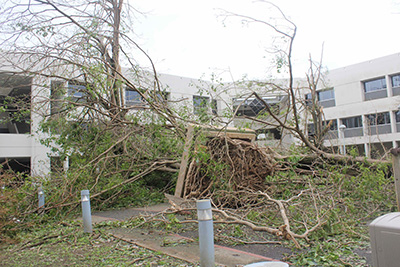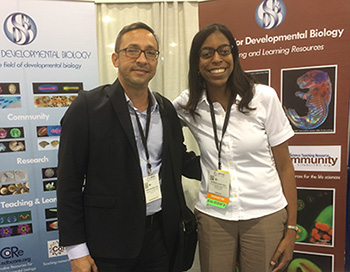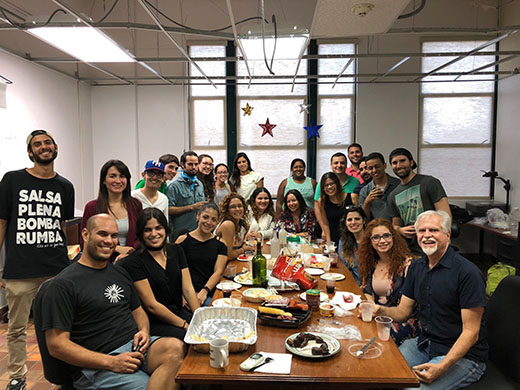Recovery continues for
developmental biology
community in Puerto Rico
By Marsha E. Lucas
Hurricane Maria hit Puerto Rico on September 20,
2017 causing widespread devastation. The Category 5
storm knocked out power to the entire island,
destroyed roads and bridges, and left many of the
island’s 3.4 million residents without safe drinking
water and ninety-five percent of the island without
cell phone service and thus a means of
communication. On October 5, 2017 the Society for
Developmental Biology announced the
SDB Puerto Rico
Research Relief Grant of up to $10,000 to help
developmental biologists in Puerto Rico continue
their research programs. Funds could be used to
replace organisms, reagents, equipment, or travel to
a host lab. Many SDB members and their friends
donated money to the SDB Puerto Rico Relief Fund to
increase the amount of assistance SDB could provide.
SDB was able to fund all
four scientists who applied for relief grants.
In early January, two grant recipients—José Garcia-Arrarás of the University of
Puerto Rico, Rio Piédras and Edwin Traverso of the
University of Puerto Rico, Humacao—shared their
stories with SDB.
Developmental Biology in Puerto Rico
José Garcia-Arrarás is a professor in the Department
of Biology at the University of Puerto Rico, Rio
Piédras where he studies organ regeneration in the
sea cucumber, Holothuria glaberrima. Thirty years
ago when he first started his lab at UPR,
Garcia-Arrarás worked on sympathetic neuron
development in the chick. His interest in sea
cucumbers began as a side project that a few
undergraduates worked on. In the 1990s, when
knockout mice were coming out and interest in chick
was going down, he decided to concentrate on
developing this novel model of regeneration. As he
likes to emphasize in his grants to the NIH, “These
animals are closer to vertebrates—to us—than
Drosophila or C. elegans.” His work focuses on
regeneration of the intestine after evisceration and
the radial nerve cord following transection. “We’re
also looking at the relationship between
dedifferentiation, cell death, and cell
proliferation. Which comes first? Which has an
effect on the other?” His lab consists of four PhD
students, two Master’s students, and about 22
undergraduates.
Edwin Traverso is an associate
professor in the Department of Biology at the
University of Puerto Rico, Humacao. He studies the
ubiquitin ligase MUSA1 which has been shown to
regulate muscle mass in adult mice. “We are
currently studying the function and regulation of
MUSA1 during Xenopus development,” he said. “We have
found that it’s expressed in the somitic tissue and
we’re trying to define the role that this gene plays
in muscle development.” Traverso, who has been at
UPR Humacao since 2007, runs a lab made up of five
undergraduates and one research associate. He is
funded through a
Puerto Rico IDeA Network Biomedical
Research Excellence (IMBRE) grant from the National
Institutes of Health which sponsors research at
primarily undergraduate institutions. Traverso is
also director of the
MARC U*STAR program at UPR
Humacao which prepares undergraduate students from
groups underrepresented in the biomedical sciences
for high-caliber graduate training at the PhD level.
UPR, Rio Piédras—The Aftermath
The University of
Puerto Rico, Rio Piédras located in the capital city
of San Juan, is the largest (and oldest) UPR campus
serving about 18,000 students. Garcia-Arrarás
described the campus immediately following the
hurricane. “The University of Puerto Rico has a lot
of trees. It’s like an oasis in the middle of the
city. So, there was a lot of debris—lots of debris
everywhere.”
|
 |
|
Inner patio of the Natural Sciences
Building at UPR, Rio Piédras following
Hurricane Maria. Credit: José
Garcia-Arrarás |
As for the labs—“It was sort of
amazing that we didn’t have major damage in the
sense that the windows didn’t break,” he said. “Most
of the damage came from water seeping through the
ceiling and some labs were more damaged than others.
We got a lot of water in my lab.”
Prior to the
storm, they took some precautions to protect
research equipment. “I’m on the second floor of a
two-floor building,” Garcia-Arrarás said. “We had
moved some of the stuff downstairs to the first
floor thinking that it would be better. But, then
water [was] seeping even to the first floor.”
Fortunately, most of the lab equipment appears to be
working.
Perhaps more damaging than the water,
was the lack of electricity. “The emergency
generator didn’t work. So, we lost electricity for
four days. And everything that was in the freezer or
in the minus eighty, we lost. I would say that was
the main damage. We lost a lot of materials.”
“The other problem was that after the hurricane, we
didn’t have electricity for a month and a half and
mold grew.” The day after the hurricane,
Garcia-Arrarás returned to his lab to begin the
cleanup. “We took everything that was damp or wet or
soaked out.” Three and a half months later, his cell
culture lab was still out of commission. It needs to
be refurbished and everything growing in it needs to
be killed.
Fortunately, because of the type of
work he does, no animals were lost. “We pick [sea
cucumbers] from nature. We go to the beach and get
them. So, we don’t keep them. We only keep them for
the experiment. . . . When the hurricane was coming,
we stopped the experiments.” He does maintain a
mouse colony for generating monoclonal antibodies.
“Luckily, the generator for the animal house worked.
. . . We didn’t lose any vertebrates.” Keeping the
electricity flowing though was a challenge. “At some
point one of the main problems here was that we
needed to get diesel for the generator. It was very
hard to get diesel for about two weeks, but it
worked out. We could keep the animals and we had no
loss.”
With his experiments on hold due to lack
of electricity, Garcia-Arrarás focused on writing a
chapter he was working on. “You learn to move to
where the electricity is,” he said. The Molecular
Science building had both power and internet. “The
other place that [had internet] access . . .
Starbucks café. I never drank so much coffee in my
life.”
UPR, Humacao—The Aftermath
The
University of Puerto Rico, Humacao is located in
Humacao, a city on the eastern coast of the island
about 35 miles southeast of San Juan. It is a
primarily undergraduate institution with about 4,000
students. Traverso described the campus after the
storm. “Immediately following the hurricane we
didn’t have water, we didn’t have power from the
Electric Power Authority of Puerto Rico, our power
emergency generators failed, and there was no
internet.”
His lab is split between two
buildings—a main lab where he does molecular and
cell biology experiments, and the building that
houses his frog room and embryology lab. “Neither
one of them were structurally damaged like other
buildings [on] our campus. For instance, we have a
building that is a total loss. Our sports complex
got severely damaged and we may not use it for a
year or longer.” Even though Traverso’s lab suffered
minor flood damage, just like the Rio Piédras
campus, weeks of no electricity and moisture led to
a severe mold problem.
His animals,
unfortunately, did not fare well. “After a week
without water or electricity of any kind either from
the [Power] Authority or from our generator, I had
to euthanize my frog colony,” Traverso said. “It was
a small frog colony compared to others in the
States, probably, but still it was a significant
amount of individuals that I had to euthanize
because we just didn’t have proper conditions for
them. And our emergency protocol dictates that after
a natural disaster, if you cannot guarantee proper
conditions for the animals, after a certain amount
of time you need to sacrifice them.”
In addition
to his animals, Traverso lost thousands of dollars
in reagents that were stored in his fridge and
freezers. “And the reagents that were at room
temperature, because we had high humidity—no air
conditioner and high humidity—those may have
suffered a lot also,” he said. As a result, all of
his reagents will need to be replaced.
Lack of
internet was a huge problem. “We didn’t have any way
to communicate for a while. And it was not until a
week or so later that in San Juan there [were] some
areas with cellular data and Wi-Fi. And anything
that you needed to do using the internet, you just
had to drive there.” Traverso made the fifty minute
drive to San Juan regularly. “I used to plan my day
sometimes just to do everything I needed to with the
internet, do it in San Juan.”
As director of the
MARC program, Traverso had to make arrangements for
his students to attend the Annual Biomedical
Research Conference for Minority Students (ABRCMS)
held in Phoenix, Arizona in November. He registered
all twelve of his MARC students for the conference
on the side of a highway in Humacao where he was
able to get cellular data. He later drove to San
Juan to buy their plane tickets where there was
stable internet.
|
 |
|
Edwin Traverso with Marsha Lucas at
the 2017 Annual Biomedical Research
Conference for Minority Students in
Phoenix, AZ. Credit: Marsha Lucas |
“Our administration was very,
very [supportive] on this,” Traverso said. “They did
the impossible for us—to do the paperwork and for
them to get the payments ready so that our students
[could] go to ABRCMS. That was a success in the
middle of the storm.”
Academics
The University
of Puerto Rico campuses were closed for about six
weeks. When classes resumed on October 30, many were
held outside in tents due to the lack of air
conditioning and mold damage.
“Some parts of the
university had electricity, and some parts didn’t,”
Garcia-Arrarás said. “I was lucky. The building I
teach [in] had electricity and had air conditioning.
So, that worked out.”
Even though the university
had power, a high percentage of the students did
not. This affected how Garcia-Arrarás taught his
neurobiology course.
“The course I was teaching
was a hybrid course where half of the lectures were
on-site and half of the lectures were online. So, I
had to move it to on-site,” he said. “I mean it was
crazy. Some people had no water, no electricity, no
Wi-Fi, no cellular phone. And then some people had
everything.”
Despite all of this, Garcia-Arrarás
has been impressed by how well the students have
managed. “I’ve had like about 10 percent drop out.
So, those are probably the students that either left
for the mainland . . . or students who really cannot
cope with the situation.” Some of his students
experienced dire circumstances and understandably
could not return. But the vast majority of his
students did.
At UPR Humacao, Traverso was
teaching developmental biology. “Because of the
exodus [to the mainland], we were expecting that our
student population would decrease dramatically, but
it is the impression of everybody [on] campus that
that was not the case,” Traverso said. “Somehow our
student population did not reflect the island
population and most students stayed. In my class of
31 students, only one student is missing. And all of
the students in my lab stayed.”
“I have to say
their attitude has been phenomenal. They are very
eager to finish the semester and continue with their
classes and getting their degrees. They’ve been a
source of motivation actually,” Traverso said.
The students, faculty, and UPR administration are
working hard to help students complete their courses
and graduate on time.
“We were supposed to finish
in the second week of December, but now I mean we’ve
lost almost two months,” Garcia-Arrarás said. To
make up this time, the only winter break they had
was Christmas Day and New Year’s Day.
“There’s
no holiday now until February. . . . Final exams are
the first week of March and then the next semester
starts the second week of March. But the good
thing—if it all works out—is that we’ll probably end
the second semester in the first week of June and
then we’re back to normal,” Garcia-Arrarás said.
Finishing the spring semester in a timely manner is
very important for UPR students who participate in
summer research programs.
“We have many, many
students that attend summer programs in the
mainland,” Traverso said. “As a MARC director I can
tell you that that’s one of the most important
aspects of our program.” Missing out on summer
research opportunities would put their students, who
are already underrepresented in the sciences, at an
even greater disadvantage.
Recovery and the SDB
Research Relief Grant
Traverso received a $10,000
SDB Puerto Rico Research Relief Grant. The grant
covers travel and housing for his research
associate, Brenda Cádiz, to spend several months in
Carmen Domingo’s lab at San Francisco State
University. Cádiz will be able to continue their
research while Traverso works to get his lab fully
functional again.
Electricity is still not
stable at UPR Humacao. Their emergency generators
work, but they are not on an automatic transfer
switch. “It’s still difficult to operate under the
conditions we’re [in],” Traverso said. “We are
starting to do experiments and we are becoming
operational slowly.”
In January he was excited
about one prospect. “I’m getting our frog room ready
for us to start receiving frogs.”
The SDB grant
will help Traverso replace his frog colony and many
reagents he lost, for which he is deeply
appreciative.
“I would like to express my most
sincere gratitude to the Society for helping us—for
remembering the members of the Society that work in
Puerto Rico, and for their genuine gesture of trying
to help us,” he said. “I know the Society. I am very
proud of being a member of it. And it was one of the
happiest things that happened to us during this time
to know that you belong to a society that
immediately went to your rescue and offered some
help.”
Garcia-Arrarás received a $5,000 grant to
replace several cell lines that produce antibodies
he uses to label cells in the sea cucumber. He also
purchased an Air Clean® Systems Combination PCR
Workstation. This will provide a contamination free
workstation free of mold and other biological
contaminants that wreak havoc when working with
mRNA.
Garcia-Arrarás expressed his appreciation
for the SDB grant which allowed him to replace
materials and reagents. Many individuals as well as
organizations offered support for scientists to go
elsewhere to conduct their research.
“For me,
that doesn’t work,” he said. “It doesn’t work
because one, I’m teaching, and two, the things I do
particularly with the sea cucumber . . . I cannot do
[in] another place.”
“I think the thing that we
need the most are funds for equipment or for
generators—things that have been lost or that will
prevent things like this from happening again,”
Garcia-Arrarás said.
The storm only compounded
the issues of an already financially strapped island
and university system. For example, the College of
Natural Sciences used to pay students to do
research. That ended when university funding was
cut.
“What we need is NIH and NSF to put money
into the university,” Garcia-Arrarás said.
He is
currently trying to get outside grants to support
students. He is also trying to procure funding
to offer summer courses so students who lost a
semester can get caught up.
|
 |
|
José Garcia-Arrarás (bottom right)
with his lab in their conference room.
The ceiling tells its
own hurricane story. Credit: José
Garcia-Arrarás |
Resilience
“This
was a very chaotic event,” Traverso said. “I had
never seen anything like this in my life. It was a
really humbling experience and a life lesson.”
The hardest part for Traverso has been “trying
to get some work done and sometimes just being
unable to do that because of the lack of power, lack
of internet, lack of water.”
José Garcia-Arrarás
echoed this. “From the experimental point of view,
you cannot do anything without electricity,” he
said.
“At some point you have to convince
yourself that that’s just . . . the way it’s going
to be for a certain amount of time,” Traverso said.
“But things will improve eventually like they are
now.”
Despite what Traverso and
Garcia-Arrarás have endured for the past five
months, they are hopeful and positive.
Garcia-Arrarás did not stress about losing his
winter break. “I’m not complaining because I think
we need to normalize. So, I’m happy,” he said.
Traverso considers himself lucky. “At my house
we didn’t have water for a month and a half and we
didn’t have electricity for about ten weeks. And we
still [in January] do not have internet or cable
TV.” But, he said, “There’s still a significant
amount of our population that [does] not have
electric power yet. And I know of some places that
don’t have water.”
The island has a long way to
go toward complete recovery. The resilience of
Garcia-Arrarás and Traverso bodes well though for
the developmental biology community in Puerto Rico.
One of Traverso’s students,
Swanny Lamboy Rodríguez,
who won a travel award to last year’s SDB Annual
Meeting in Minneapolis based on her presentation at
ABRCMS in 2016, will be graduating this semester.
She has been interviewing at top graduate schools
throughout the United Sates and was invited by the
Massachusetts Institute of Technology to be a
visiting student beginning in February.
Garcia-Arrarás and Traverso are committed to
creating many more academic and scientific successes
like this
one in Puerto Rico.
|